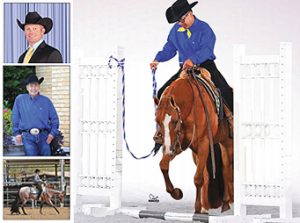Breaking Down the Trail Transition
Click here to read the complete article34 – July/Aug, 2018
BY ALISON FOSTER GREEN
 The transition is a crucial, but often overlooked tool in a rider’s arsenal. Often viewed as a simple pause between maneuvers, the transition is one of the main components necessary for every event. Consider Horsemanship, Equitation, or Trail. In these classes, a pattern can contain between 10-20 transitions, ranging from the simple (a walk-to-jog transition) to the more complex (an extended trot-to-lope transition). For these classes, riders are typically highly attuned to the transitions, practicing them at home and in the warm-up pen, knowing that a botched transition can make or break their performance.
The transition is a crucial, but often overlooked tool in a rider’s arsenal. Often viewed as a simple pause between maneuvers, the transition is one of the main components necessary for every event. Consider Horsemanship, Equitation, or Trail. In these classes, a pattern can contain between 10-20 transitions, ranging from the simple (a walk-to-jog transition) to the more complex (an extended trot-to-lope transition). For these classes, riders are typically highly attuned to the transitions, practicing them at home and in the warm-up pen, knowing that a botched transition can make or break their performance.
The transition is especially crucial in a Trail class, when a rider only has a few seconds after leaving one obstacle before entering the next. However, because Trail transitions typically take place in between the scored maneuvers, they often get overlooked as riders focus their attention on the obstacles themselves. This is a mistake, and it’s one that affects the overall outcome of a Trail performance.
As course designer and AQHA/APHA judge Robert Dehn says, “Most Trail patterns, especially at the big shows, have just as many transitions as they have maneuvers. Half of your pattern is transitions, and this is deliberate. As a course designer, I incorporate transitions to make a pattern more challenging, deliberately using them to separate the ‘good’ patterns from the ‘great’ patterns.”
For Trail designer and AQHA professional Horseman, Tim Kimura, the transition is the introduction to judging a maneuver. While the transition isn’t what dictates a plus or minus, it’s the judge’s first impression. “If you look organized, it adds a positive note to your maneuver. However, if you’re disorganized and your horse stutters or launches, even if you don’t hit any logs on the maneuver, you probably won’t earn a plus score.” AQHA judge and trainer, John Briggs, echoes Kimura with a straightforward assessment of the importance of transitions. He says, “The better someone rides the transition; the more likely they are to earn a plus on the connected maneuver.”
In this article, four industry experts deconstruct the Trail transition, discussing why it’s such an important part of a Trail course, how to avoid common pitfalls, and how to improve your transitions and your overall score.
Click here to read the complete article34 – July/Aug, 2018










